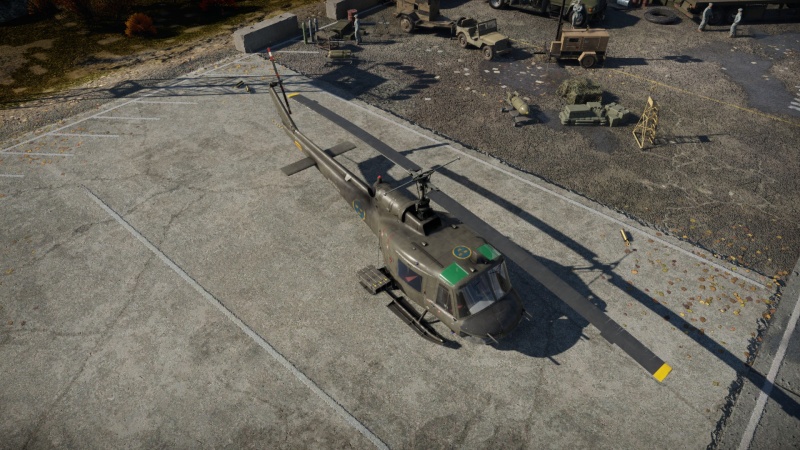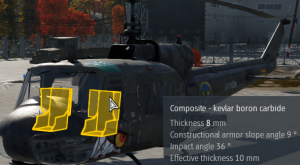HKP3C
Contents
Description
The HKP3C was originally based on the Italian license-manufactured variant of the Bell 204B (UH-1). Originally acquired in 1962 for helicopter rescue services, the platform saw extensive use in both the Swedish Air Force and Army. Serving for nearly 40 years, the HKP3 went through two modernization programs relating to its powerplant. Originally being delivered as the HKP3A, the type was quickly deemed underpowered prompting the decision to give it a more capable engine, redesignating it as the HKP3B. While this solved the problem of handling, the Army saw more potential in increasing the lift further by lengthening the tail and extending the rotor, thus creating the HKP3C we see represented in game. While the platform was not originally designed for anti-tank missions, the Army did extensive trials to incorporate the BANTAM missile to the HKP3. Although these tests were deemed successful, the military opted to not procure any missile armament for the type.
Introduced in Update "Wind of Change", the HKP3C is the introductory helicopter for Sweden. As it is one of the earliest examples of ATGM-carrying helicopters, it faces much less advanced threats while still being able to engage from a safe distance. While these missiles pack a significant punch compared to unguided rockets, the tradeoff comes at velocity as they take an extreme amount of time to reach the target, requiring patience and strategy to utilize correctly.
General info
Flight performance
As the HKP3C is a utility helicopter by nature, the flight performance is mostly a result from the carrying capacity the platform was made for. As the Huey family was primarily designed for troop transportation the resulting agility is favourable compared to usually larger or weaker utility helicopters. The HKP3C sports a fantastic climb rate that holds up even against more modern examples. Keeping the nose pointed at targets is easily done thanks to the well responding control surface, albeit with slight limitations. Since the helicopter was mostly designed to quickly move between locations, it struggles to perform more advanced combat manoeuvres, especially when trying to roll the aircraft.
| Characteristics | Max speed (km/h at 0 m - at sea level) |
Max altitude (metres) | |
|---|---|---|---|
| AB | RB | ||
| Stock | 204 | 195 | |
| Upgraded | 229 | 217 | |
Survivability and armour
- Armour
Two armour plates surround the seats of the gunner and pilot, protecting them from any shrapnel from behind.
- 8 mm Kevlar boron carbide - Seats of gunner and pilot
Modifications and economy
As the HKP3C gets its full weaponry stock, all research can be dedicated to flight performance and survivability. It is recommended to focus on engine upgrades for greater climb rate. Quickly researching Flak jacket is also preferable as it greatly increases pilot survivability, which comes in handy when in close combat against machine guns.
Armaments
Suspended armament
The HKP3C can be outfitted with the following ordnance:
- 6 x RB 53 Bantam missiles
Usage in battles
Since the HKP3C is one of the first examples of anti-tank helicopters available for research, the characteristics and gameplay usually revolves around its limitations. While the improved Huey platform offers great power, mobility and carrying capacity, the nature of it being primarily for utility limits both how agile and survivable the helicopter is. This means the HKP3C can easily get into position, but often struggles to defensively act when confronted by enemy vehicles.
Counteracting these downsides can be done in two different approaches, depending on situation and terrain. The first being a more distanced gameplay, focusing on utilizing the 2 km range the BANTAM missiles offer. While these travel at painstakingly slow speeds, the damage and pinpoint accuracy they provide more than offsets the problem. Since the HKP3C is situated at a low battle rating, there is rarely any SPAA that can have a clear shot when using terrain to its advantage. The only counterbalance of this playstyle is how much it relies on enemy positioning. While other missiles usually reach the target before it relocates, the BANTAM requires a firing window that's usually far over 20 seconds in travel time, giving opponents ample time to avoid the missile by driving into cover either on purpose or by accident. Since the missiles require visual with the target to guide, trying to accurately guide them onto an opponent from a distance leaves the HKP3C vulnerable for an equal amount of time, making SPAA countering, one of the strengths of helicopters, near impossible to perform.
The second playstyle is centered around trying to maximize the efficiency of the BANTAM missiles by closing the traveling distance, lowering the amount of time spent on each target. The best way to perform this playstyle is by staying low to the ground while approaching the battlefield, then using the horizontal momentum to gain altitude over the target area. By pivoting the helicopter to fire straight downwards, players can essentially use the low speed of the BANTAM to accurately guide them onto the rooftops of unsuspecting tankers below. This requires a lot of practice and getting familiar with helicopter controls, but can allow for multiple threats to be dealt with in a short timeframe. While this can on paper be the most effective way to play the HKP3C, put into practice the reckless approach will often leave the craft vulnerable to SPAA and roof-mounted machine guns. Selecting between the two different playstyles should as such be done by evaluating which one seems the most effective given the map and state of the match. Spawning the helicopter early in a smaller map will often favour the second approach, while a later spawn on more open large-scale maps more commonly favour the first approach.
Pros and cons
Pros:
- Great engine power - high top speed and climb-rate
- Fairly agile
- Equipped with 6 very manoeuvrable anti-tank missiles
Cons:
- Slow missiles with a very short range
- Poor roll-rate
- No guns or rockets
- No night vision devices
- No air-to-air weaponry
History
The HKP3C was Sweden's main utility helicopter between the 1960s and early 2000s. It was originally based on the Italian license-manufactured version of Bell 204B, a civilian version of the UH-1 Huey. Even though it was intended to be used in search and rescue missions, it soon found use in other areas.
As a utility helicopter, the Swedish Air Force and other branches of its military used it for recommendations missions, anti submarine patrols, medevac and transportation of troops and supplies. Unlike the American variants of the Huey, the Swedish military never used the HKP3C directly for combat, so it was not armed, however it was used for air cavalry squadrons as a mean of transportation and quick deployment and for transfer of supplies between different forces. In fact, the Swedish military was one of the first to adopt the usage of air cavalry squadrons and helicopter based infantry in their doctrine.
The Swedish military did test the use of BANTAM missiles in the HKP3C, but even though the test was a success, the military decided not to follow through with the idea. Thus, the HKP3C remained as a utility helicopter. During the 1980s, the HKP3C received upgrades in order to extend its life in service. The Air Force started a program to incorporate better avionics, navigation systems and other equipment into the helicopter. The most important upgrade was the introduction of night vision goggles in the early 1990s to improve visibility in night time operations and other low light conditions. The helicopter also received new engines and an increase in the tail length to increase its total lift.
By the 2000s, the HKP3C was already aging, and it was soon replaced by newer helicopters, including the NHIndustries NH90 and the UH-60M Black Hawk.
Media
- Skins
- Videos
See also
External links
Paste links to sources and external resources, such as:
- topic on the official game forum;
- other literature.
| Agusta | |
|---|---|
| Utility | AB 205 A-1* · A.109EOA-2 |
| Attack | A-129 International (p) · A129CBT · AH-129D · T129** |
| Export | HKP3C |
| See Also | Bell Aircraft Corporation · TAI |
| *Licensed · **Partnership with TAI | |
| Sweden helicopters | |
|---|---|
| Attack | |
| Havoc | Mi-28A |
| Apache | AHS |
| Utility | |
| Alouette | HKP2 |
| Huey | HKP3C |
| BO 105 | HKP9A · HKP9A (FC) |






